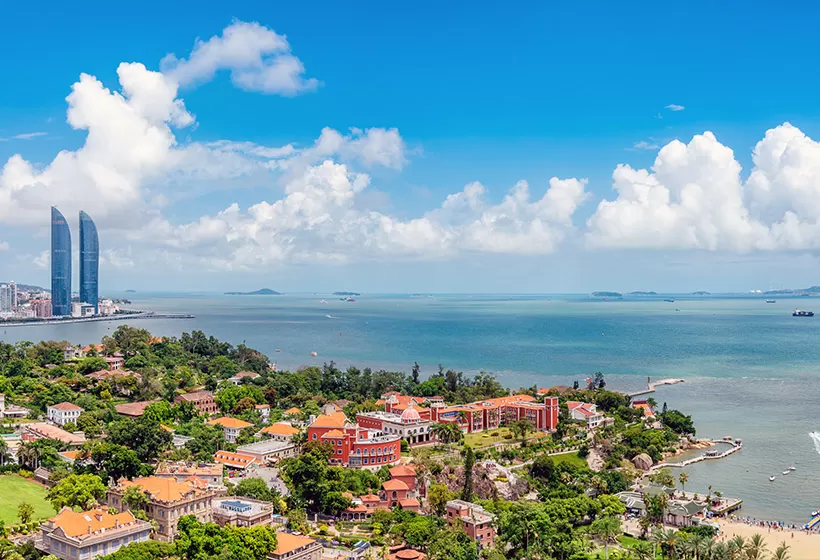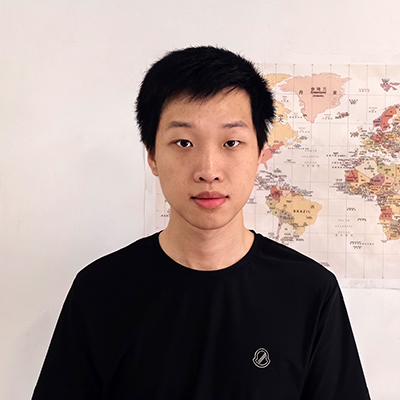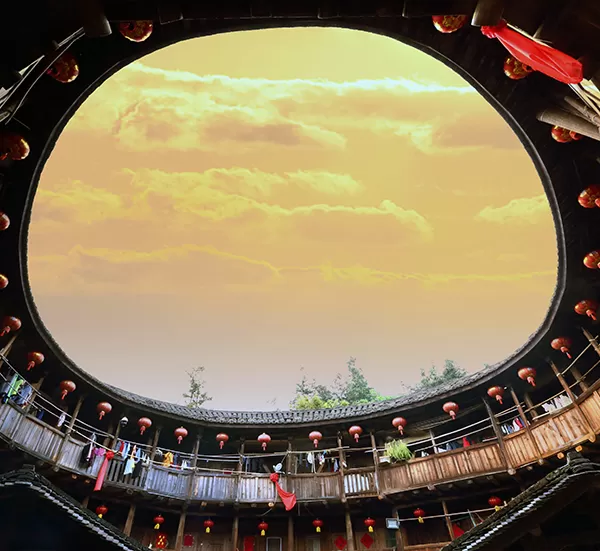Top 10 Famous Tourist Attractions and Sightseeing in Xiamen
Xiamen, this Egret Island kissed by sea breezes, weaves poetry with its azure seas and skies, and preserves history in its red-brick heritage homes. When you set foot on this land, every crashing wave tells a story, and every waft of tea aroma beckons from afar. Here are the Xiamen top 10 attractions.
Top 1: Gulangyu
Gulangyu, or Kulangsu, is an island located in the southwestern corner of Xiamen, facing Xiamen Island across the sea. Covering an area of approximately 1.88 square kilometers, the island enjoys a pleasant climate year-round, with a spring-like atmosphere in all seasons. Free from the hustle and bustle of vehicles, it is filled with birdsong and the fragrance of flowers, resembling a dazzling pearl set in the emerald waters of Xiamen Bay, known as the "Garden on the Sea".
Gulangyu Island is a symbolic landmark of Xiamen, featuring rugged reefs, meandering coastlines, lush mountains, and layered rock formations. Its bright and elegant coastal scenery draws countless tourists, inspiring the saying: "A trip to Xiamen is incomplete without visiting Gulangyu".
The island is home to over a thousand buildings of various styles, blending Chinese and Western architectural elements. These include traditional Chinese temples with flying eaves, courtyard-style houses in the Minnan style, the uniquely structured Bagua Building combining Chinese and Western features, exquisite Japanese residences, 19th-century European-style consulates from former Western countries, and the outstanding example of classical Jiangnan gardens.
Gulangyu integrates historical heritage, cultural depth, and natural beauty. It preserves more than a thousand architecturally diverse buildings, maintains a rich musical tradition, and hosts China's first and world-class piano museum, as well as the world's largest and China's only organ museum, earned the nicknames "Island of Pianos" and "Home of Music".
- Address: Gulangyu Island, Siming District, Xiamen
- Open Hours: 00:00 AM – 12:00 PM
- Tour Length: 6-12 hours
Top 2: Xiamen Science and Technology Museum
Xiamen Science and Technology Museum is one of the most advanced comprehensive science museums in China and a popular family-friendly travel destination, often hailed as the "Disneyland of Science“”. Upholding the philosophy of "Make Science More Fun", the museum serves as a vital window into Xiamen's identity as a city of culture, art, and technology. It has five themed exhibition halls, 400 interactive experience projects, and three immersive theaters, attracting over one million visitors annually.
The Museum of Ocean, titled Ask the Ocean, guides visitors through layers of inquiry starting from everyday life, encouraging joyful exploration of marine science. The Museum of Discovery is divided into five sections, optics, acoustics, mechanics, electromagnetism, and biology, emphasizing the joy of science through interactive and comparative learning. The Museum of Creating showcases cutting-edge modern technologies such as interactive multi-media, artificial intelligence, and automobile manufacturing. The Museum of Life, themed Human · Life · Science, demonstrates the harmonious interactive relationship between human beings and life sciences. The Museum of Children offers a learning environment filled with inspiration and fun tailored for young minds.
In addition to the five major themed halls, the museum features three theaters: a fantasy theater that blends reality and illusion, a story-rich 4D Flying Cinema, and a thrilling 720Rider motion theater. Together, they provide visually stunning and exhilarating experiences that engage all the senses.
- Address: No. 95, Tiyu Road, Siming District, Xiamen
- Open Hours: 09:00 AM – 05:00 PM, closed on Mondays
- Tour Length: 3-12 hours
Top 3: Xiamen University
Beside the Baicheng Sandy Beach lies Xiamen University (XMU), known as one of China's most beautiful universities. Founded in 1921 by renowned patriotic overseas Chinese leader Mr. Tan Kah Kee, it holds the distinction of being the first university in modern Chinese history established by an overseas Chinese, and remains one of the most desired institutions among students across the country. Facing the sea and backed by verdant mountains, XMU possesses a graceful and elegant charm.
The serene Lovers' Valley, century-old buildings in the distinctive "Tan Kah Kee style", the gracefully curved Upper Arc Field, the jewel-like Furong Lake nestled within the campus, and the youthful graffiti lining the Furong Tunnel…, amidst the interplay of all these views, the campus breathes a profound poetic beauty. The rustling pines atop Wulao Peak, the morning bells and evening drums of South Putuo Temple, and the crashing waves at Baicheng Sandy Beach, all contribute to the charm of Xiamen University, whose beauty lies not only within its campus but also in its seamless connection with the surrounding landmarks.
"Leaves like the feathers of a soaring phoenix, and flowers like the crown of a crimson phoenix"—in Xiamen, clusters of blazing red royal poinciana bloom with passionate vibrance. As the most iconic tree of Xiamen University, the phoenix flower bursts into full bloom every June and July. Its swaying branches and fiery blossoms set the trees ablaze with color, telling a tale of midsummer's exuberance and tender romance.
- Address: No. 422, Siming South Road, Siming District, Xiamen
- Open Hours: 00:00 AM – 12:00 PM
- Tour Length: 2-12 hours
Top 4: South Putuo Temple
South Putuo Temple is located beneath Wulao Peak in the southeastern part of Xiamen. It sits adjacent to Xiamen University and faces the clear blue harbor, covering a total area of 258,000 square meters with a building area of 21,270 square meters. It was originally built in the late Tang Dynasty, annd fell into decline during the early Ming Dynasty and was not rebuilt until the Kangxi period of the Qing Dynasty. Dedicated to Guanyin, similar to another Guanyin worship site in Zhejiang, and located south of Mount Putuo, the temple was named "South Putuo", and is one of the major centers of Buddhism in southern Fujian.
The temple is built facing south, backed by mountains and overlooking the sea, grand and solemn. All buildings in the temple follow the palace style, with large, double-eaved roofs and upturned ridges adorned with yellow glazed tiles, making a unified and harmonious aesthetic. The structures are enclosed by stone walls, resembling pearls held in a tray, forming an integrated whole.
Wulao Peak rises by the Xiamen harbor and stands next to South Putuo Temple. Its five jagged summits pierce the sky, majestic and awe-inspiring. At times, the peaks are shrouded in drifting clouds, giving the illusion of five white-haired elders gazing thoughtfully out to sea. Climbing to the top rewards visitors with a sweeping view of the scenic Xiamen University campus and the expansive harbor below.
- Address: No. 515, Siming South Road, Siming District, Xiamen
- Open Hours: 08:00 AM – 05:00 PM
- Tour Length: 2-4 hours
Top 5: Zengcuo'an
Zengcuo'an, known as the most artistic fishing village in China, is located in the southern part of Xiamen and boasts a history of over 800 years. Bordered by Huangcuo Sandy Beach to the east, adjacent to Xiamen University to the west, facing Dadan Island across the sea to the south, and reaching Yuping Mountain to the north, this charming village spans about 6.5 square kilometers, surrounded by mountains on three sides and the sea on one.
Originally a fishing village nestled between mountains and sea, Zengcuo'an nurtured generations of fishermen with its unique and rare environment. From its origins as a small fishing village in the Ming and Qing Dynasties, to a coastal defense outpost during the liberation period, to an artistic village on the fringes of an economic zone, it has now evolved into a romantic and creative hub filled with family-run inns and quirky little shops.
Traces of overseas Chinese who once lived here remain visible throughout the village. Many red-brick ancient houses and Southeast Asian–style foreign buildings constructed by returning Chinese immigrants are still well preserved. Narrow alleys crisscross the area, lined with a vibrant array of street food stalls, handicraft shops, cafés, guesthouses, and bars. Each storefront is small and quaint, adorned with just the right touch of greenery and whimsical hand-painted signs, full of personality and charm, inviting visitors to pause and explore.
- Address: No. 110, Huandao South Road, Siming District, Xiamen
- Open Hours: 00:00 AM – 12:00 PM
- Tour Length: 2-8 hours
Top 6: Jimei School Village
Jimei School Village refers to the collective name of all schools and cultural institutions in Jimei, located in Jimei Village on the Jimei Peninsula of Xiamen. It was founded in 1913 by the renowned overseas Chinese leader Mr. Tan Kah Kee, who invested heavily in its establishment,enjoying widespread fame both domestically and internationally.
Jimei School Village is not only is a place of outstanding talents but also a scenic tourist destination. Here, the architecture blends Chinese and Western styles, showcasing the typical features of buildings in southern Fujian's overseas Chinese communities. Whether it is the grand and imposing school halls or the delicate and elegant pavilions and corridors, all are topped with glazed tiles, dragon-ridged roofs, and intricate wood carvings and paintings, but on closer inspection, every structure displays its own unique design, without repetition—this architectural style has been named the "Tan Kah Kee Style".
Near the Jimei School Village metro station lies the Miles Long Dike, a popular spot for leisure activities such as camping, street performances, and creative trunk markets. Two heart-shaped sculptures, one large and one small, have become romantic landmarks of the dike, attracting countless visitors for photos. As waves crash against the rocks and the sun sets over the sea, gentle love songs by young musicians fill the air, hence the romantic atmosphere lingers throughout the entire Miles Long Dike.
- Address: No. 183, Yinjiang Road, Jimei District, Xiamen
- Open Hours: 08:00 AM – 06:00 PM
- Tour Length: 2-6 hours
Top 7: Xiamen Botanic Garden
Xiamen Botanical Garden is located in the Wanshi Mountain at the southeastern corner of Xiamen Island. It is backed by Wulao Peak, South Putuo Temple, and Xiamen University, and is adjacent to the bustling Zhongshan Road. Renowned as a "Green Museum", Xiamen Botanical Garden is home to over 10,000 plant species, making it the first botanical garden in Fujian and the eighth in China to reach such biodiversity, which is a true "Noah's Ark" of plants in Xiamen.
Step into the ethereal Rainforest world and admire lush vegetation while experiencing the magical fog forest system. This dreamlike "fairyland" is shrouded in soft, white mist, perfect for capturing photos that exude an otherworldly and poetic atmosphere. In the tropical style Succulent Garden, an array of succulent plants grow in varied heights and shapes, with vibrant greenery all around. Some cluster together, some rise tall, others are round and adorable, or refined and elegant. On the north side of the Herbaceous Garden lies the warm room of Peculiar Plant Garden. Large glass eco-tanks lines one side one by one, showcasing over 20 species of carnivorous plants such as pitcher plants, sundews, and Venus flytraps. Their bizarre forms, some resembling bottles, others like clamps or sticky-tentacled creatures, never fail to amaze, revealing the extraordinary creativity of nature.
- Address: No. 25, Huyuan Road, Siming District, Xiamen
- Open Hours: 06:30 AM – 06:00 PM
- Tour Length: 2-5 hours
Top 8: Zhongshan Road Pedestrian Street
When people think of Xiamen, aside from Gulangyu Island, Zhongshan Road often comes to mind—much like Manhattan in New York, Ginza in Tokyo, or Central in Hong Kong. Located in the bustling Siming District, Zhongshan Road Pedestrian Street, or Amoy Yatsen Street, is one of Xiamen's oldest commercial streets. Since its opening, it has remained the commercial hub and economic heart of the city. Stretching 1,198 meters long and 15 meters wide, one end connects to hotels that welcome guests from around the world, while the other leads to the shimmering sea, facing the island garden of Gulangyu across the waters. Zhongshan Road represents the prosperity of old Xiamen and pulses with the rhythm of the times.
Zhongshan Road is one of the best-preserved historic blocks in Xiamen that showcases the architectural character of modern Chinese history. The rows of arcaded buildings, rich Southeast Asian flair, winding alleys, and variety of local snacks from Fujian and Taiwan, along with the ancient Fujian accent echoing through, together preserve the city's precious cultural memory. Though a century of changes and commercial development may have faded some of its original "Xiamen style", the cultural heritage and cherished old-world memories remain. Today, they continue to greet every visitor who steps onto this historic street.
- Address: No. 56, Zhongshan Road, Siming District, Xiamen
- Open Hours: 00:00 AM – 12:00 PM
- Tour Length: 2-3 hours
Top 9: Hulishan Cannon Fort
Hulishan Cannon Fort is located in the southwestern part of Xiamen Island, near Xiamen University. Historically known as the "Gateway to Eight Min" and the "Key to Southern China", it is a product of China's Self-Strengthening Movement. Covering over 70,000 square meters, with the fortress area itself spanning more than 13,000 square meters, Hulishan Cannon Fort is divided into a battle platform area, barracks area, and rear area. Inside, there are hidden passageways, protective walls, ammunition depots, soldiers' quarters, officers' halls, and a mountaintop observation tower. The fortress architecture combines semi-bunker and semi-wall structures, reflecting both European and traditional Ming-Qing Chinese styles.
The Krupp cannon in the Battle Platform Area is the world-renowned "King of Cannons", holding the title of "the world's largest 19th-century breech-loading coastal cannon still preserved in its original emplacement". In the Rear Area, the iron-molded iron cannon is a rare relic of China's modern iron-mold casting technique, considered as a precious treasure of the fortress. Today, visitors to Hulishan Cannon Fort can also enjoy various performances, such as Hongyi (Red Barbarian) Cannon drills and welcoming ceremonies.
- Address: No. 2, Zengcuo'an, Siming District, Xiamen
- Open Hours: 08:00 AM – 06:00 PM
- Tour Length: 2-3 hours
Top 10: Shapowei
Shapowei, the birthplace of Xiamen Port, has served as a typhoon shelter since the Qing Dynasty. It is located on the southwestern coast of Xiamen Island, adjacent to South Putuo Temple and Xiamen University to the south. In its early days, Xiamen Port was a crescent-shaped bay, with a golden coastline stretching over a kilometer. The continuous expanse of beach, smooth and lustrous like jade, earned it the name "Jade Sand Slope".
As the tide recedes, weathered wooden boats lie scattered on the sand like stranded fish bones, while fishing nets, spread out to dry, air into geometric works of art. Around the corner, the aroma of coffee mingles with the nostalgic scent of traditional Minnan snacks, weaving through the air. Shapowei, once a humble fishing village sheltering boats from storms, has aged into a place of unique charm, part bustling local life, part refreshing artistic vibe. Young entrepreneurs and artisans have gathered here, infusing the alleys with trendy elements, transforming Shapowei into one of Xiamen's must-visit cultural landmarks.
- Address: Shapowei, Siming District, Xiamen
- Open Hours: 00:00 AM – 12:00 PM
- Tour Length: 1-3 hours
GREAT FAMILY CHINA TOUR
JULY 2024 We wanted to thank Grace at China Culture tour for organizing a great tour of China. We enjoyed our Beijing - Xian-Chengdu -Guilin -Yangshuo - Shanghai trip. Our local guides Bruce in Beijing, Susan in Xian, Jane in Chengdu, Mike in Guilin and Mary in Shanghai took care of us…read more details »
Teng Han L from SINGAPORE
Ready to Create a Unique Dream Travel?


